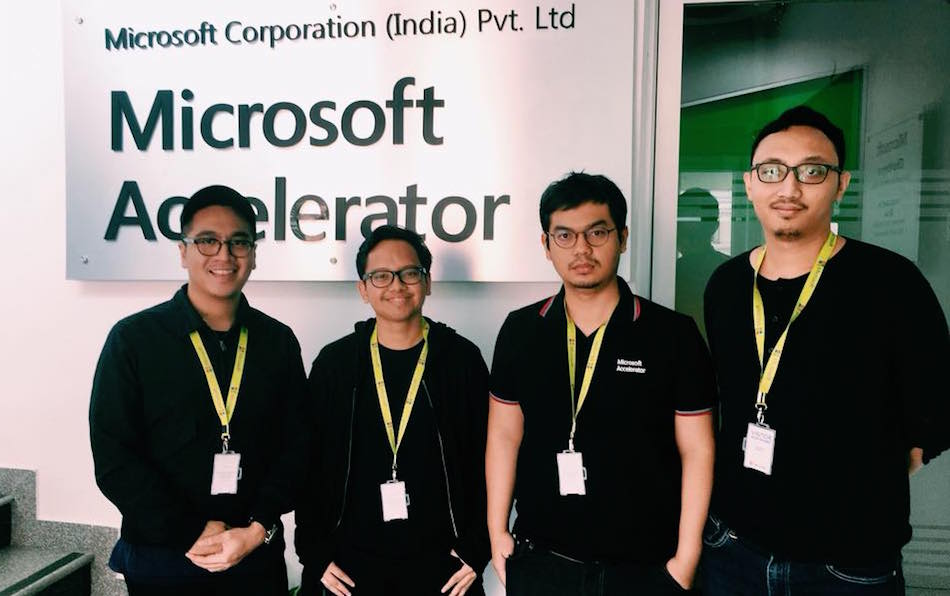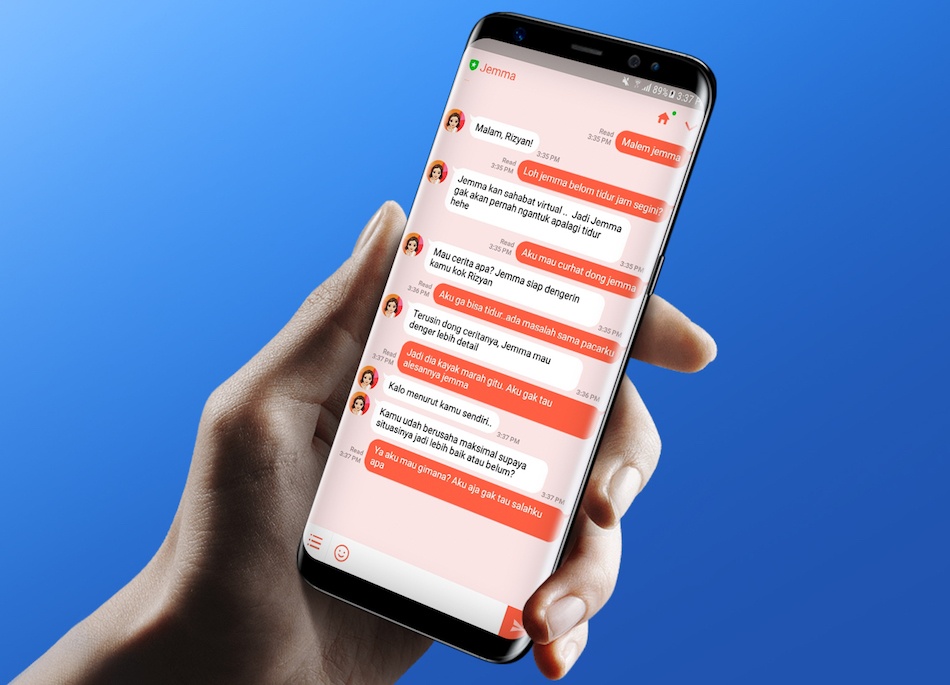Lessons an Indonesian AI startup learned in an Indian accelerator

Kata CEO Irzan Raditya (second from left) with his team at Microsoft Accelerator in Bangalore / Photo credit: Kata
The recent graduation function of Microsoft Accelerator’s 11th cohort in Bangalore had an unusual participant: Irzan Raditya, CEO and co-founder of Kata.ai, the first Indonesian startup to join this growth-stage accelerator program in India’s tech hub. The 13 other startups in the batch were all Indian.
Apart from a newfound love for Indian food, Raditya showed off his understanding of Indian mythology when I chatted with him about his takeaways from the six-month program. “You’ve got to be your own Brahma, Vishnu, and Shiva,” he says.
You’ve got to be your own Brahma, Vishnu, and Shiva.
Brahma is the creator, Vishnu represents sustenance, and Shiva is the destroyer or transformer. In startup parlance, the entrepreneur begins with a creation or innovation. Then the pioneer attracts competitors and tries to use first-mover advantage to sustain the innovation. But sooner or later, the graph is going to flatten and go down. “That’s the point where you have to become your Shiva,” says Raditya.
In the case of Kata, its previous avatar was YesBoss, an SMS-based virtual assistant that was shut down in late 2016. It gave way to AI-powered Kata chatbots that use natural language processing to help enterprises engage with customers in the conversational Bahasa spoken in Indonesia.
Now, with a US$3.5 million series A investment led by the Taiwanese Trans-Pacific Technology Fund, Kata aims to expand into Taiwan and Japan. This will involve adding new languages like Mandarin to its repertoire.
At the same time, it has opened up a platform that provides the tools, libraries, and services for developers from any company to build their own chatbots. For Kata, the expansion out of Indonesia as well as its platform to build robust Asian-language-speaking bots are part of its vision to be a global company.
Platform model

Photo credit: Kata
The stint in Bangalore not only gave Kata the courage to expand abroad but also an understanding of the right strategy to use. There are hardly any Indonesian B2B (business-to-business) or enterprise tech startups with a footprint in global markets, whereas the ecosystem for doing this is well-developed in India, points out Raditya.
A key learning was to team up with a partner for large clients, instead of going it alone. This deepens the engagement with clients, broadens the pipeline for enterprise sales, and eases expansion into new markets. It also shapes product strategy.
Kata has a partnership with global consulting firm Accenture for deploying its chatbot Veronika in Indonesia’s state-owned mobile operator Telkom. “This form of partnership is not that common yet in Indonesia because we barely see enterprise-quality tech products in the market,” says Raditya. “We have seen a lot of solution providers. They build everything from scratch or pick this and that for the client, like a software house or consultant […] We are playing it differently by becoming an enterprise-class conversational chat platform.”
It seems counterintuitive to open up its bot-building platform to others when Kata makes its own bots for enterprise clients. But it ties in with Kata’s vision. As Raditya puts it, “You have to see the end game first, and work backwards from there.”
“Every startup should think about the bigger picture, how they can sustain the ambition in the long run, and not just focus on short-term tactical moves. It’s crucial to see how you can proceed on your vision.”
Take Kata’s experience in serving large enterprise clients like Telkomsel and Unilever, which in turn serve hundreds of millions of customers. “It forced us to build a strong infrastructure that is scalable and flexible,” says Raditya.
The chatbot-builder platform has a modular tech infrastructure. Different parts of it – like machine learning, natural language processing, data training for accuracy, and the dialogue engine for chatbots – can be accessed by multiple parties with API calls. It also protects the core IP, which does not get exposed on user premises or shared with clients.
“Our platform has been designed to be able to carry billions of messages a day. And it’s flexible, so it doesn’t limit the functionality for you to play around. It can unleash your creativity, be it for customer services, financial advisory services, HR, sales, or marketing – it’s not an issue for us when it comes to the use cases,” says Raditya.
Kata’s platform model also helps to build bots that are not just linear in their interactions. Its aim is to provide the capability for 360-degree conversations, jumping from topic to topic, which is closer to how humans converse. Advancements in AI are moving the needle on natural language processing, but it also requires flexibility in how a bot functions.
A chatbot with 1.5 million friends
Landing big clients like Telkom and Unilever has been both a blessing and a challenge for Kata. “Typically, when you’re a B2B startup, you can scale slowly based on your growth or marketing. But in this case, we had to be ready on Day 1. We understood that we were serving the biggest telecom and fast-moving consumer goods companies, and they get millions of requests.”
This is where channel partners like Microsoft and Accenture can help in ensuring that the underlying infrastructure makes the usage scalable, flexible, and fast to deploy.
“Previously, when we started up the project for Unilever, it took us nearly four months to build it from scratch. We didn’t have a platform,” recalls Raditya. “And then a few months ago, we rebuilt the bot using the platform that was ready. It took less than three weeks. So, you have to think exactly at the granular level, the features you are delivering, and how to extract them. You don’t repeat yourself.”
Kata needs to anticipate needs at two levels: the first is the enterprise or client level, and the next is the end customer who needs a fast response, ease of use, integration with her favorite messaging apps, and so on.
At the same time, Kata takes care to factor in the needs of its channel partners. This is the sort of long-term approach that left an impression on Raditya in his interactions with peers and mentors in India’s enterprise tech space. “You have to work for the partner’s success as well. You cannot simply present your product once and then let them sell it. You have to nurture them, give them the full arsenal, because they are indirectly your evangelist.”
On their part, Microsoft Accelerator and Accenture Ventures recently announced a partnership to support growth-stage B2B startups in India specializing in AI and other new age tech. They intend to provide access to Accenture’s global clients as well as Microsoft’s global network. “Today, the need is to create a collaborative environment and bring startups and corporates together to co-innovate,” says Bala Girisaballa, CEO of Microsoft Accelerator.
The last couple of years have seen highs and lows in the hype cycle for chatbots. But as Kata and others figure out better ways to use them, and messaging apps continue to flourish with the spread of smartphone usage in Asia, we could see chatbots becoming more important for enterprises in engaging with their consumers.
Take Unilever, for instance. Kata made a bot for it called Jemma with a female persona to chat with Indonesians on their popular messaging app Line. Within a year, Jemma had 1.5 million friends, who not only chatted with her about products but even made her a confidante, sharing their personal problems.
“While it is clear from the start that Jemma is just a chatbot, somehow users continue to confide to Jemma because apparently, it felt like conversing to a real person, a best friend,” says Kata in a blog post.
However, this does raise ethical questions over the extent to which brands should use such conversations for consumer insights. Perhaps that’s also something that a conversational bot platform like Kata should tackle better than cases of bots running amok on social media.








0 komentar:
Posting Komentar